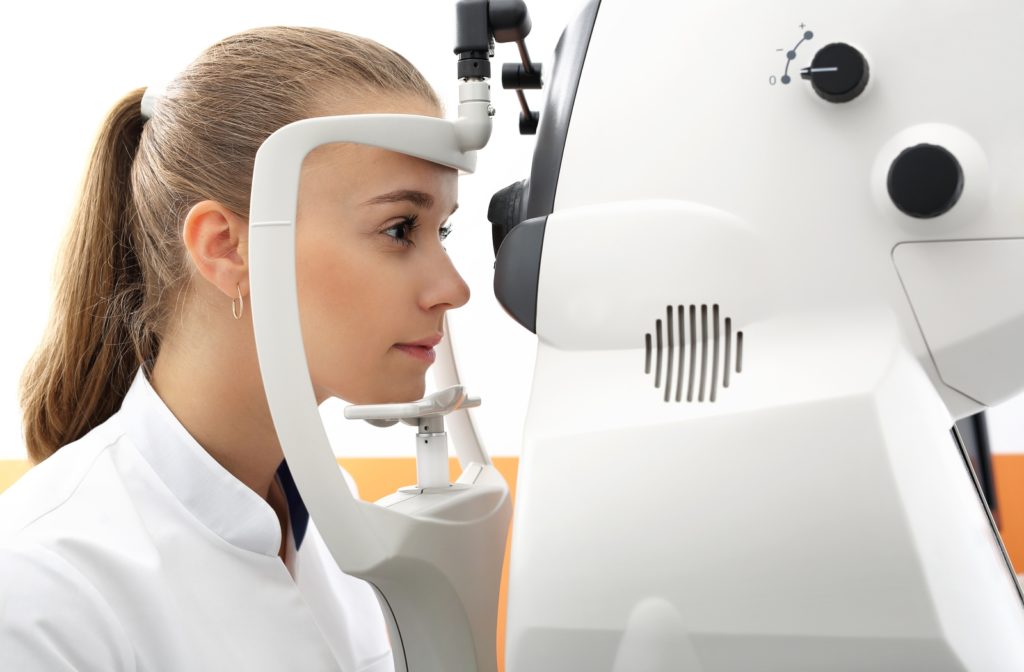Mapping Your Visual Field
Our optometrists can determine so much more than your corrective lens prescription when you come in for an eye exam. We can run tests to help diagnose diabetic eye problems, glaucoma, and other eye diseases that may not have apparent symptoms.
Your visual field holds clues to your overall vision health. Book an appointment to map your visual field and in the meantime, read on to discover more about the types of visual field tests and the eye problems that can be detected.
Visual Field Test
Your visual field is the entire area you can see when looking at a single point. It includes the things seen directly in the path of what you’re looking at (your central vision) as well as what can be seen all around that point—above, below, and off to the sides. This is commonly called your peripheral vision.
Visual field tests determine the scope of your visual field, as well as the quality of your vision across all areas of the visual field. The tests measure both how far you can see in your peripheral vision without looking from side to side, as well as the sensitivity of your peripheral vision.
Types of Visual Field Tests
Confrontational Visual Field Testing
Confrontational visual field testing involves your optometrist staying a few feet away from you while you remain in the same spot with one eye covered, looking straight ahead. Your doctor will hold an object, picture, or even their fingers in your side vision. As you watch, you’ll let them know if the object disappears or becomes difficult to see.
This very basic and simple test doesn’t require any specialized equipment, yet is an effective way to determine if there are any blind spots in the peripheral vision.
Goldmann Field Exam
The Goldmann field exam, also called a tangent screen exam, is done on a computer. You will be seated 3 feet away from the computer, looking at a central spot and not moving your eyes. Pictures will appear on the edges of your peripheral vision, and your eye doctor can build a map of your visual field based on which images you see.
Automated Perimetry Test
The automated perimetry test is a computerized test. The forehead and chin rest against a dome-shaped instrument, and while looking at a precise spot, flashes of light will appear in your peripheral vision. Whenever you see a light, you’ll click a button.
The map built of the peripheral vision from these clicks helps your optometrist understand your peripheral vision and detect any problems in your visual field.
Amsler Grid
The Amsler grid consists of a simple black and white grid pattern with a dot in the center. Looking at this grid can help determine any issues with the central visual field. Any places where the grid lines appear wavy, blurred, or absent can indicate a vision problem.
Your Part in the Test
Many visual field tests rely on you accurately reporting your visual experiences during the exam. The most commonly used tests need your input about your vision in order to build a map of your peripheral vision. If anything about your part in the test is unclear to you, be sure to ask your eye care team questions.
Your optometrist may have you repeat the test more than once at relatively close intervals, like appointments only months apart. Since the test is subjective, results can be swayed if the patient is tired or missed any instructions.
The test will also be administered regularly if a visual problem like glaucoma is found. This can help your doctor track and monitor vision loss even before it’s apparent to you.

What Do Visual Field Tests Help Detect?
Glaucoma
Glaucoma is a group of conditions that attack the optic nerve, causing visual field loss and eye damage. Different types of glaucoma can affect vision at different rates. Since many types of glaucoma only have noticeable symptoms in the advanced stages, a visual field test can offer insight into glaucoma progression.
Visual field tests are a key part of glaucoma diagnosis and treatment. Testing the visual field helps optometrists monitor the progression of glaucoma. Changes in your visual field test can indicate the effectiveness of any medication being used to treat glaucoma.
Retinitis Pigmentosa
Retinitis pigmentosa is a rare genetic eye disease that results in the deterioration of the cells on the retina. It is a very uncommon condition, affecting only 1 in 4000 people worldwide, but it can be detected through a visual field test.
Retinitis pigmentosa affects the photoreceptors in the eye, called the rods and cones. Rods help us see in low light and make up the bulk of the photoreceptors, especially on the outer parts of the retina. Cones are responsible for detailed vision. Rods are affected by retinitis pigmentosa first, causing damage to the peripheral vision.
Stroke
A stroke is a medical emergency where the blood supply to the brain is cut off, reduced, or interrupted. Brain cells can begin to die immediately. Fortunately, as education about signs of a stroke increases, so do survival numbers—80% of Canadians now survive having a stroke.
Higher rates of survival mean more people living with the effects of a stroke, including vision problems. Visual field loss occurs in up to half of people who have had a stroke. A stroke can also cause:
- Poor central vision
- Abnormal eye movement
- Visual perfection deficits
Brain Tumours
Brain tumours, particularly types like optic glioma, can sometimes be detected during visual field testing. Since tumours can press on parts of the visual system like the optic nerve, they disrupt messages between the eyes and brain. This can lead to reduced vision, double vision or vision loss.
The Importance of Visual Field Tests
Visual field tests are an important part of your ocular health care plan. Regular visual field testing can help monitor potential vision loss over time and gives your optometrist insight into how your eyes are working. Scheduling regular comprehensive eye exams are crucial for maintaining eye health, especially if you live with diabetes or eye disease.
Book Your Next Eye Exam
Making sure you have the results from a visual field test on the books when your eyes are healthy is a great way to help monitor any vision changes as they occur. It gives you and your eye care team a baseline to work from.
Don’t wait until vision problems arise to come for an eye exam. Book an appointment at Legacy Eye Care in Stony Plain. We’re here to safeguard your family’s vision.



